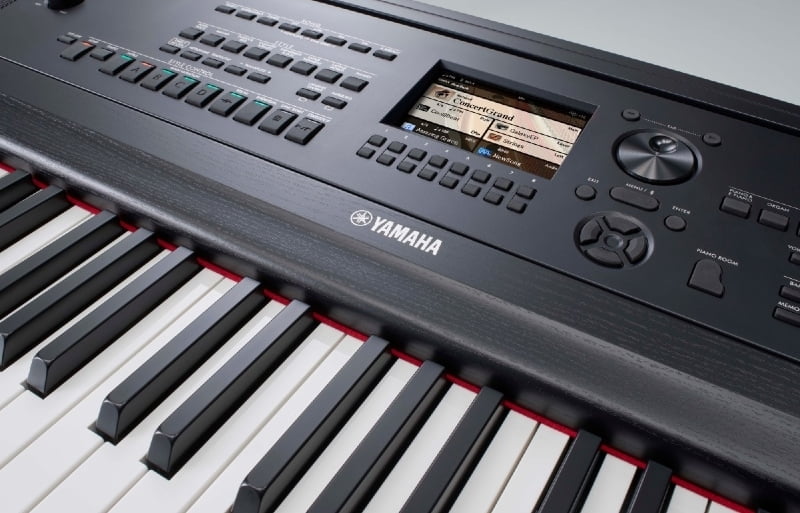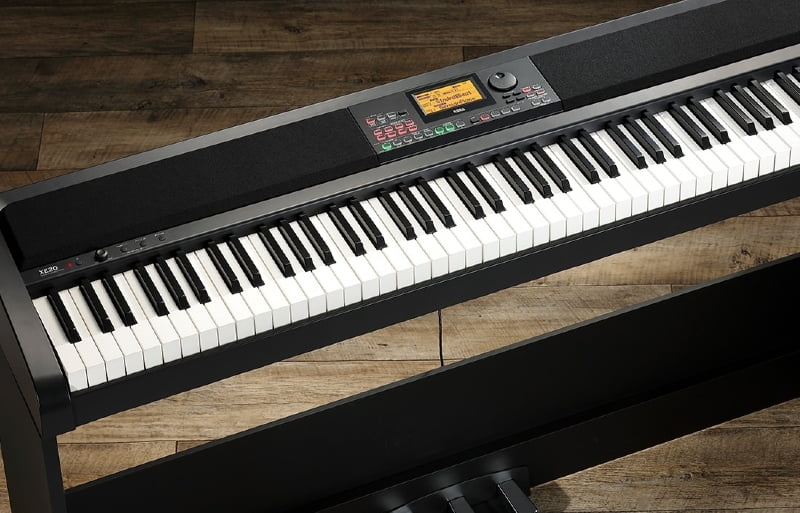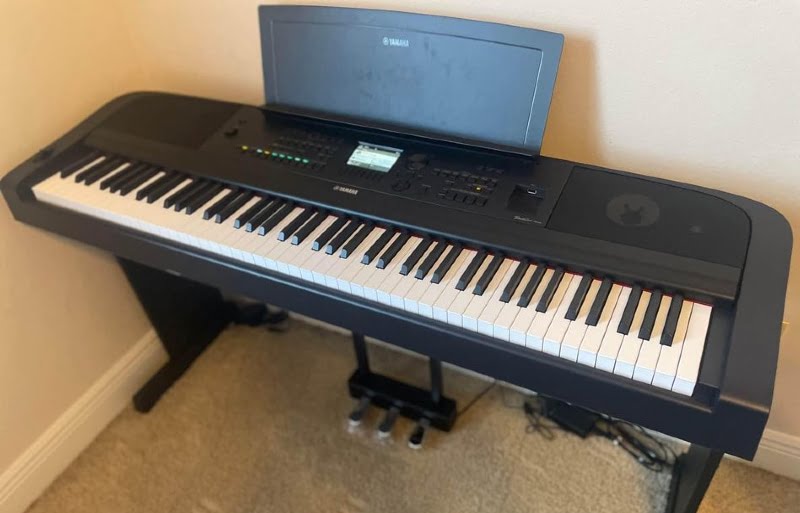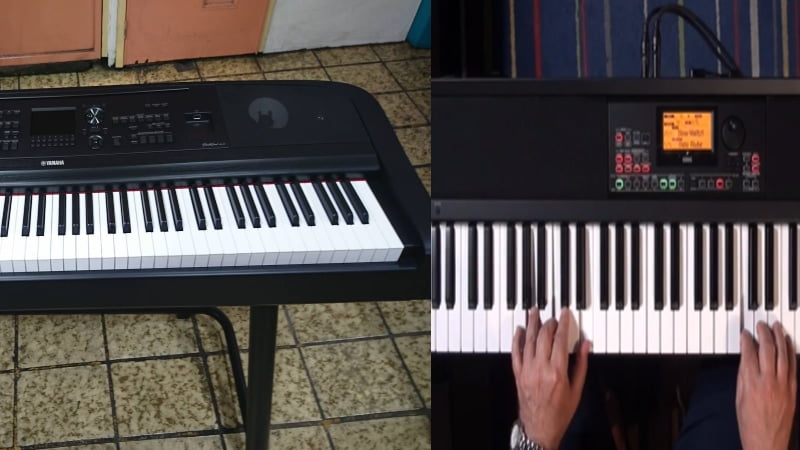Learn the pros, cons, and features of both pianos as we find out the best option in this Yamaha DGX 670 vs Korg XE20 review.
So, do you think it’s finally time for you to buy a premium digital piano?
Then there’s a high chance that you’ve been considering the Yamaha DGX 670 and the Korg XE 20. These are typical choices when people look for pianos in higher price ranges. They are by far some of the best options in the sub-$1,000 range.
These are both arranger pianos, so they come with various features that allow you to play live, record music, and master the art of playing the piano. But between the two, which one is better?
This was a really difficult question to answer. But after testing both pianos and doing deep research on their features, benefits, and drawbacks, I found that the Yamaha DGX-670 sneaks out with a win.
While it was a close battle, the Yamaha DGX-670 eventually came out on top. And in this Yamaha DGX-670 vs Korg XE-20 comparison, I’ll explain why.
By the end of this article, you’ll have a clear picture of both pianos, making it much easier to choose the right one for you!
Yamaha DGX 670 vs Korg XE20: Comparison Chart




Last update on 2025-07-12 / Affiliate links / Images from Amazon Product Advertising API
Yamaha DGX 670 vs Korg XE20: A Head-to-Head Comparison
I tried out both pianos and paid close attention to three specific areas: feel, tone, and piano features. This would be the most objective way to compare both pianos. And by the end of the tests, I tallied the score, and it was 3-2 in favor of the Yamaha DGX-670.
As you can tell by the score, it was a really close fight decided by very thin margins. I found that both pianos would make great investments for any pianist. But if you’re looking for a bit more versatility, the Yamaha DGX-670 is the better option.
Feel
The winner: Tie
Both of these pianos had great hammer action systems that made it feel like I was playing a real acoustic piano. They both had very detailed hammer action systems that captured all the slight weight differences on piano keys. So, if you’re looking for a digital piano that feels like an acoustic piano, both of these instruments would serve you well.

+Hammer Action
These pianos use different hammer action systems designed to meet the same goal. The hammer action systems on the pianos feature heavier keys on the lower end of the piano and lighter action on the higher end of the piano. This is the same way an acoustic piano is set up, and this feature was very nice to find on both pianos.
That said, the Yamaha uses the Graded Hammer Standard while the Korg uses Natural Hammer action. While they feel very similar, I felt a slight difference when testing the pianos. The Korg feels a bit more natural when playing, but I actually enjoyed the weight of the GHS system a bit more.
At the end of the day, the better hammer action system is all a matter of preference. And while I preferred the Yamaha, I wouldn’t blame you if you enjoy the Korg’s feel better.
Tone
The winner: Tie
The next feature I focused on is arguably the most important feature of any digital piano: the tone. Usually, it’s hard to compete with the tone quality of Yamaha pianos. However, I was surprised to find that the Korg actually put up a fair fight, and it even has a larger sound library. But after playing both pianos and trying out all the sounds, I couldn’t choose a winner between the two, so both of them came out with a point.
+Tone Generator
Since these pianos are far from entry-level, they both come with sophisticated tone generators. That said, none of them come with a dedicated tone engine and still rely on samples to deliver their sounds. However, I have to say that the samples on both pianos are much better than what you’d typically get, which is why these instruments can produce top-quality sounds.
To start, the Yamaha DGX-670 uses the Pure CFX sound engine. This sound engine contains samples from Yamaha CF Grand Pianos. These instruments are known for bright trebles and resonant bass tones, which you can definitely hear on the Yamaha DGX-670. In fact, you’d be very hard-pressed to find a digital piano in this price range that produces more realistic tones.
Korg doesn’t have the benefit of recording Yamaha CF Grand Pianos. Instead, they use the Stereo PCM tone generator. This basically means that the piano is loaded with stereo PCM samples, which are known to retain much more clarity and detail than typical MP3 recordings.
The Korg’s piano tones don’t have the same resonant bass as the Yamaha DGX-670. However, the tones have a distinct quality to them, and many pianists may prefer this over the Yamaha DX-670.

+Sound Library
These are arranger pianos designed for versatility, so you can expect them to come with many voices. The Yamaha DGX-670 has a great sound library with around 630 tones. That said, keep note that some of these voices don’t come from the CFX sound engine so you can expect a slight dip in quality for some voices.
The Korg has a much richer sound library with over 750 different voices. But just like the Yamaha, not all of them are top-quality. My issue with this is that while you have many options for voices and tones, you likely won’t be able to use all of them, especially if you’re particular about tone quality.
Piano Features
The winner: Yamaha DGX-670
The deciding factors when comparing these two instruments were the piano features. This is where the Yamaha showed why it’s one of the top options in this price range. Aside from having better polyphony, it came with a better set of effects, which gives you a lot of versatility when playing. So, the Yamaha ended up taking the point and eventually winning in this comparison.
+Polyphony
The Yamaha DGX-670 comes with 256-note maximum polyphony. This is about as good as it gets at this price range and most pianists won’t complain about this piano. With this high polyphony, you can expect more clarity, longer sustains, and better tones when combining two voices with layering modes.
The Korg XE-20, on the other hand, only comes with 184-note polyphony. Now, this is far from bad. In fact, it still beats out many other pianos in the sub-$1,000 range. But while you can do a lot with this polyphony, it’s definitely not as flexible and versatile as the Yamaha DGX-670.
+Effects
The Korg XE-20 has multi-effects sets in place. This allows you to experiment and play around with various effects like reverb and chorus. This is great, but I noticed that the multi-effects systems don’t produce the most realistic and high-quality sounds.
On the flip side, the Yamaha DGX-670 comes with singular effects with user and factory presets. This includes reverb, chorus, DPS, master EQ, and more. And when comparing the effects of both pianos, I found that the Yamaha DGX-670 does a much better job compared to the Korg XE-20.

Yamaha DGX 670 vs Korg XE20: The Similarities
The major similarity between these two pianos is that they are both arranger pianos. These are instruments designed for performing musicians. It comes with many preset songs that you can play along with your chords so that it seems like you’re playing with a whole band. This comes in handy when playing solo or with a vocalist, which is why they come with such versatile effects set.
On top of that, both pianos are portable. While they are on the heavier side, they easily load into a car or gig bag that you can take to your performances. So, if you’re a performer looking for a piano that you can bring around with you and use for performances, both of these options will serve you better.
The only reason I chose the Yamaha DGX-670 as the winner is because of the extra versatility you get with the piano features. And while this made a huge difference for me, there are many pianists that would be more than happy with the features on the Korg XE-20.
Quick Rundown of the Yamaha DGX 670
- CFX Stereo Sampling faithfully reproduces the sound of Yamaha's flagship CFX Full Concert Grand.
- GHS weighted action is heavier in the low keys and lighter in the high keys, just like an acoustic piano. The special matte black key tops are designed to absorb moisture and remain tactile after extended use without becoming slippery.
- Adaptive Style automatically shifts between the Main Style Variations by changing your velocity and number of notes played.
- Unison and Accent function adds a doubled voice to your melody line and musical "hits" when you accent your notes.
- Smart Chord lets you play great-sounding chords from simple Pop triads to complex jazz 7th chords with just a few fingers.
Last update on 2025-07-12 / Affiliate links / Images from Amazon Product Advertising API
Quick Rundown of the Korg XE-20
- 88-key Digital Ensemble Piano with Hammer Action
- 280 Accompaniment Styles
- Built-in Speaker System
- Arranger Functionality
- 705+ Sounds
Last update on 2025-07-12 / Affiliate links / Images from Amazon Product Advertising API
Product Video
Related Articles to Korg Xe 20
Related Articles to Yamaha Dgx 670
- Yamaha DGX-670 vs YDP 144: Finding the Best Digital Piano
- Yamaha DGX 670 vs Casio PX S3000: Which Piano Comes Out on Top?
- Yamaha DGX 670 vs Roland FP 60x: Which Piano Comes Out on Top?
- Yamaha P125 vs DGX 670: Which Piano Comes Out on Top?
- Yamaha DGX 670 Vs P515: Which Gives You Bang For Your Buck?
- Yamaha DGX 670 Vs 660: The Distinct Difference In Details You Need To Know About
- Yamaha DGX 670 Vs Roland FP 30x: Which Works Better For Your Needs?
References:
- Yamaha DGX-670: https://www.sweetwater.com/store/detail/DGX670BK–yamaha-dgx670b-88-key-black-portable-grand-includes-pa150-power-adapter-and-sustain-pedal-black
- Korg XE-20: https://www.korg.com/ph/products/digitalpianos/xe20/specifications.php
Lulacruza is an electronic folk duo operating at the junction of the hypermodern and the ancient. Our music weaves together hypnotic female singing, South American folk instruments and electronic processing, while channeling pulsating waves from the source of creation.
Lalucruza is also a community where you can connect with other music lovers to collaborate, exchange ideas and share knowledge. A platform for who wants to learns the basics of playing piano, guitar, drum masters’ technique, etc.. is the premise of our website.
